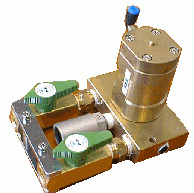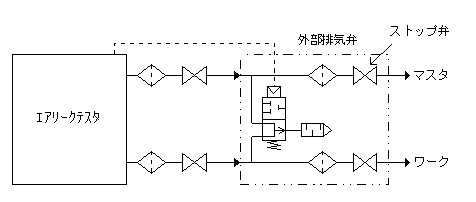


Leak testers and related products
Leak testers and related products
Daily leak sensitivity checks and calibration
Pressure, flow meters and related topics
Q1.What are the advantages of using air leak testers?
A
- Automatic tests are made possible, requiring less manpower compared to water-dunk tests.WORK does not get soiled, since no liquid is used.
- The test standard can be quantified, eliminating products overlooked by human misjudgment.
- Tests of high precision can be performed in a short time. The running cost is low, helping to cut costs.
Q2.What is the difference between the leak testing methods of differential pressure detection and gauge pressure decay (direct pressure detection)?
A
| Differential pressure detection method | Gauge pressure decay method | |
|---|---|---|
| Sensitivity | Not limited to the test pressure, the differential pressure sensor can use the minute differential pressure range, allowing for leak tests which are highly precise. | A pressure sensor corresponding to the range of the test pressure is used, lowering the resolution as the pressure gets higher, making the leak detection sensitivity worse. |
| Effects of temperature deformation | ・ Effects of the rise in temperature of the sealed air or changes in temperature are offset by being compared with MASTER, and are thus minimal. ・ The resolution is high, so measurement is possible, even with a short detection time. Therefore, longer time can be taken for pressurization and stabilization, allowing for a test with less inaccuracies due to air temperature or deformation. |
・ Effects of the rise in temperature of the sealed air or changes in temperature are present as inaccuracies. ・ Sensitivity is low, requiring a longer detection time.When the pressurization time is shortened to compensate, much inaccuracy will be present due to effects of air temperature and deformation. |
| Adaptability | ・ Even when the test pressure is changed, a common differential pressure sensor can be used. | To achieve maximum sensitivity, a sensor with a range matching the test pressure must be used. |
Q3.What are some units describing leaks?
A
1 atm·mL/s or atm·mL/min The volume of air leaking into the atmosphere per second or per minute. “atm·” is often omitted.
1 μgr/s or μgr/min The weight of air leaking into the atmosphere per second or per minute.
1 μgr (microgram) => 0.83 × 10 − 3 mL (at 1 atm, 20°C)
1 Lusec A leak rate of an increase in pressure of 1 µHg per second in a vacuum chamber of 1 L.
1 Lusec = 1/760 mL/sec ≃ 1.32 × 10 − 3 mL/s
1 Torr·L/s A leak rate of an increase in pressure of 1 Torr per second in a vacuum chamber of 1 L.
1 Torr・L/s=1000 Lusec≒1.32 mL/s
1 Pa・m3/s
1 Pa・ m3/s = 9.869 atm mL/s
1atm・mL/s = 1.013 × 10-1Pa・m3/s
Q4. Leak testers detect the change in pressure using a differential pressure sensor. How is it that they can also directly read and display the flow (leak rate)?
A
During the stabilization or detection stage, the differential pressure ΔP is calculated according to the equation below after auto-zero is performed, and the leak rate is displayed in its unit (mL/s or mL/min).
![]()
Q:Leak rate (mL/s)
K(Ve):Volume equivalent (mL)
ΔP:Differential pressure (Pa)
ΔT:Time (s)
If the leak rate does not change and remains constant during the detection stage, no additional detection time is required, and the testing time could also be shortened.
Q5.When performing a leak test, the test pressure is set to positive pressure (pressurization) in some cases and negative pressure (vacuum pressure) in others. What are the characteristics of each?
A
| [メリット] | [デメリット] | ||
|---|---|---|---|
| Pressurization method | ・ Test by applying positive pressure ・ Target: For WORK which would be used at high internal pressure, WORK which would contain liquids |
・ Detection rate can be increased by increasing the test pressure ・ Leak locations can be checked by visually checking for bubbles |
・ Susceptible to changes in pressure (by changes in temperature, effects of deformation, etc.) |
| Depressurization method | ・ Test by vacuum pressure by pulling the part in a vacuum ・ Target: For WORK which would be used in vacuum pressure, WORK which would change in temperature or shape during testing |
・ Not susceptible to causes of change in pressure (changes in temperature, deformation, etc.) | ・ Testing pressure is limited compared to positive pressure; leak rate would be smaller from the same hole diameter ・ Affected by vapor pressure of water or oil。 ・ Locations of leaks cannot be checked |
Q6.What is the difference between the MASTER comparison method and the simultaneous comparison method, and the advantages of each?Also, what are the advantages of the multi-comparison method?
A
| Method | [メリット] | [デメリット] | |
|---|---|---|---|
| MASTER comparison | ・ Method: comparison with a standard fixed MASTER ・ Target: For WORK in general |
・ Leaks over a certain value are not overlooked ・ Can be used with WORK with a high fail rate |
・ Compared to simultaneous comparison, more susceptible to effects of changes in WORK temperature or shape, or deformation of tooling seals |
| Simultaneous comparison | ・ Method: Compare WORKs to each other・ Target: For WORK with a low fail rate, WORK affected by temperature or deformation | ・ Detection precision is higher, since it is affected less by effects caused by temperature or deformation・ Test time can be reduced | ・ Not detected if two products with similar leaks get paired ・ Two sets of test tooling are necessary ・ Cannot be used if fail rate is high |
| Multi-comparison | ・ Method: a test combining MASTER comparison and simultaneous comparison, using two WORKs and one MASTER ・Target: For WORK affected by temperature or deformation |
・ Test time can be reduced. ・ Can detect two products with similar leaks paired together。 ・ Can be used even if fail rate is rather high |
・ A reliable valve without temperature increase, deformation, or leak is required to switch among measuring systems. ・ Two sets of test tooling are necessary |
Q7.What is the volume equivalent?Also, what is the relationship between the volume equivalent and the leak rate?
A
(1)Volume equivalent
The amount of differential pressure due to leaks depends on the internal volume of the measuring system as a whole, including WORK and the tester.This also strongly related to measurement time.
With air leak testers, we use as this internal volume a coefficient called volume equivalent (Ve), which accounts for the effects of causes for pressure change throughout the measuring system as a whole (volumetric changes due to the internal pressures of WORK or the differential pressure sensor).等The volume equivalent can be calculated using the following equation.With the air leak tester LS-1842 series, the auto leak calibrator (ALC) or the leak MASTER can be used to measure the value of Ve directly.。
Ve=Vw+Vt+{Ks(1+Vw/Vm)+Kw}(101.3+P)
Ve:Volume equivalent (mL)
Vw:Internal volume of WORK and tubing (mL)
Vt:Internal volume of tester (mL) Vt = 9 mL
Ks:The ratio of volumetric change of the sensor per pressure unit (mL / kPa)
Kw:The ratio of volumetric change of WORK per pressure unit
P:Test pressure (kPa)

Under conditions
Ks(1+Vw/Vm)+Kw=2Ks
l Ks=0.01mL/kPa above
Ve=Vw+Vt+0.02(101.3+P)
l Ks=0.005mL/kPa above
Ve=Vw+Vt+0.01(101.3+P)
(2)Leak rate
The relational expression for volume equivalent and leak rate Q
![]()
Q :Leak rate (mL / min)
ΔP:Differential pressure (Pa)
Ve:Volume equivalent (mL)
T:Detection time (s)
Q8.How should the pressurization time and the stabilization time be determined?
A
Finding pressurization and stabilization time
When setting the measurement time while performing experiments or startup adjustments, confirm first that there are definitely no leaks in WORK or the toolings. Then, start with ample pressurization time to obtain data.
Gradually shorten this time and find the shortest pressurization and stabilization times where data is stable around zero.
Guidelines:
For Intelligent 1 Pneumatic Circuit(対象リークテスター型式: LS-1866、LS-R700など)
Pressurization time (CHG) to Stabilization time (BAL) = 3 to 1 or 4 to 1
For Intelligent 2 Pneumatic Circuit(対象リークテスター型式: LS-1881、LS-R900、LS-R700など)
Pressurization time (CHG) to Stabilization1 (BAL1) to Stabilization2 (BAL2) = 5 to 5 to 1
Note: When WORK volumetric capacity is low, pressure equalizing time is not required.Set BAL1 to 0 seconds.
These times usually depend on the condition of the actual machinery, equipment, and tooling, as well as the characteristics of WORK, and therefore must be found by experimentation.They can also be estimated for WORK which have been used in the past.
Required pressurization and stabilization time (Pressurization time CHG + Stabilization BAL) ↓
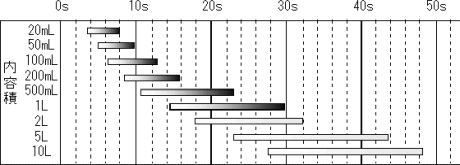
Low pressure <- Test pressure -> High pressure
![]()
※The above graph does not include detection time.
※Time can also change depending on the precision required.
Q9. Is there anything that can act as a standard for leaks?We don’t have WORK with a known leak, nor can we make one.Is there a good solution?
A
We have a product Leak MASTER LM-1C (Patents No. 2042571, 2042578).
- It causes a constant leak accurately for a long period, stably.
- This allows for issue of a traceability certificate.
- It can be installed directly into the CAL port on the front surface of the tester. (May not be possible on some tester models)
- When installing on WORK tubing, use the included adapter (connection R1/8—M10 × 1.5).It can easily replace a sealing plug.
- When ordering, specify the ranges of test pressure and leak rate below.
- Test Pressure: 1 kPa to 0.5 MPa, −13 kPa to −53 kPa
- Leak rate: 0.1 to 20 mL/min
- We accept special custom orders.
- Flow data for each pressure point is attached, and can be used, for example, to find the volume equivalent and to check the leak coefficient (K).
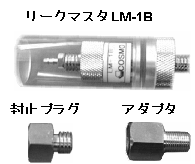

Q10.Please explain the structure of the MASTER chamber and the advantages of using it.
A
(1)Theory and structure
((In the MASTER comparison method, a Pass product without leaks is used as MASTER. The MASTER chamber is used in place of that MASTER.)
When WORK is pressurized, the temperature of the air inside it rapidly increases, but decreases as it exchanges heat with the interior surface of WORK.The characteristics of the temperature in this situation are greatly affected by the ratio of the internal volume to surface area. The greater the surface area, the temperature stabilizes more quickly, as does pressure.When MASTER detects differential pressure between it and WORK, this works to negate the change in pressure which arises from this decreasing curve in temperature.
The number and arrangement of fins can be changed inside the MASTER chamber to change the volumetric capacity and surface area, to match the decreasing curve in temperature with that of WORK.

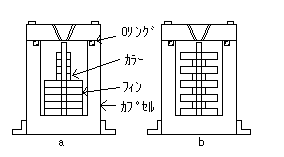
(2)The advantages of using a MASTER chamber
- It can be adjusted to the characteristics of WORK.
- It does not take up much space.
- It costs less than using WORK to make MASTER.
- It has a O-ring seal, so it can be used without worry against leaks for a long period of time.
- Coupled with mastering and automatic drift correction, one MASTER chamber can work with many different WORKs.
Q11.Is there a way to perform a leak test on WORK with some oil residue?
A
Try using an external exhaust valve. This is a sample external exhaust valve.
- When small amounts of water, oil, or similar substances are left inside WORK or when it is used in a testing device which is used in combination with water-dunking, such foreign matter could be blown from WORK into the tester with the exhaust and cause malfunction.Such malfunction can be prevented.by setting up this exhaust valve unit close to WORK.
- It uses a special air-operated valve with a structure which is resistant also to solid waste.
- The movement of the exhaust valve can be controlled by the tester body.
